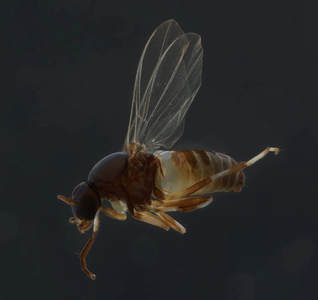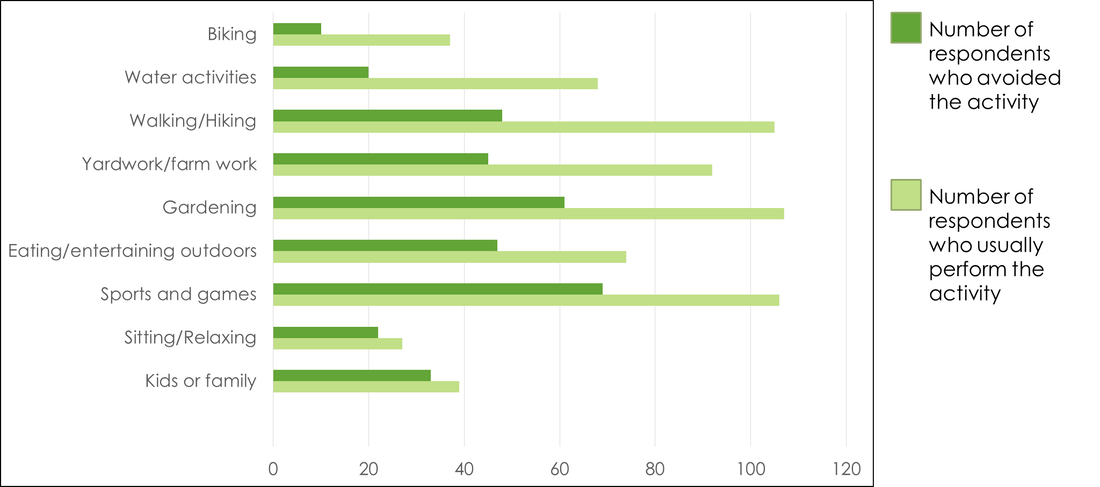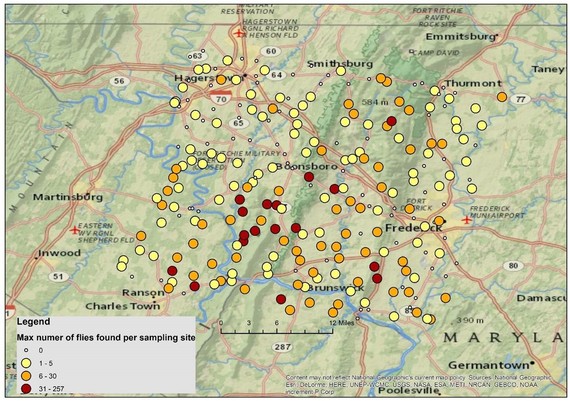The relationship between humans and the “gnat-like” pest - the black fly, Simulium jenningsi9/24/2018
 Black fly, Simulium jenningsi; Photo credit: Jake Bodart Black fly, Simulium jenningsi; Photo credit: Jake Bodart Written by: Lisa Kuder, PhD student, vanEngelsdorp Lab & Kelly Kulhanek, PhD student, vanEngelsdorp Lab Swarming, biting insects that shroud their victims in a seemingly inescapable cloud can certainly put a damper on outdoor activities. This is a common scenario in parts of the Mid-Atlantic Region situated near fast-moving rivers like the Potomac. In 2013, the public and economic impacts of biting insects moved residents from Washington County, Maryland to seek help from their state delegate and from UMD’s aquatic insect lab. The main culprit that locals tend to call “gnats” turned out to be black flies, Simulium jenningsi (Order: Diptera). In response to complaints about the nuisance fly, Becca Wilson-Ounekeo, a PhD candidate in UMD’s Entomology Department, set out to learn more about the biology, distribution, and public impact of the black fly. She soon embarked on research that would incorporate citizen-science and intensive field work. Becca found that the localized nature of the S. jennningsi nuisance make the black fly an appropriate study system for exploring how biological and societal factors can affect the geographic range and the impact of a species on people. A better understanding of how residents perceive the pest is important for the success of management programs. Presently, the best management solution for black flies is Bti (Bacillus thuringiensis israelensis), a natural soil bacteria that is non-toxic to humans and most non-target insects. This toxin kills aquatic larval stages of certain dipterans, such as mosquitos and black flies [1]. While effective, pre-2017 Maryland did not have an area-wide Bti program to combat black flies, leaving few options for residents. To determine resident and management needs, Becca conducted online and in-person interviews. Her research goals were threefold: 1) describe trends in resident perception of black fly nuisance across demographics and localities, 2) assess the severity of the impact of black flies on resident quality of life and 3) to determine which preventative strategies are used against black flies and their perceived effectiveness [2]. Becca’s survey results show that the majority of 231 respondents covering 55 ZIP Codes were “extremely annoyed” by the pests, particularly on-line respondents and those with children. As shown in the graph below, trends could be seen in the respondents that avoided some activities. Interestingly, while biking and engaging in water activities, respondents perceived fewer black flies. Why? Becca hypothesized that the flies might not be able to keep up with cyclists, who are usually moving at a good clip and water activities may be less impacted due to the biology of the species. While the black fly’s larval or immature stage is entirely aquatic, their adult life is terrestrial. Females leave fast moving rivers in search of nectar to fuel flight and blood meals, which are necessary for reproduction, from birds, small mammals and humans.  Avoided activities bar graph based on 231 responses by residents in Maryland and its surrounding states. The lighter green bars represent the number of respondents who performed a given activity, whilst the dark green bars reflect the number of respondents who avoided that same activity due to the black fly nuisance. Graph provided by Becca Wilson-Ounekeo.  The black fly density map shows the maximum number of black flies found at each sampling site throughout Central and Western MD. The color of the dot relates to the specified range of flies netted where white = 0, yellow = 1 – 5, orange = 6 – 30 and red = 31 - 257. Graph by Becca Wilson-Ounekeo. The black fly density map shows the maximum number of black flies found at each sampling site throughout Central and Western MD. The color of the dot relates to the specified range of flies netted where white = 0, yellow = 1 – 5, orange = 6 – 30 and red = 31 - 257. Graph by Becca Wilson-Ounekeo. Survey respondents were also asked to report the preventative measures they took against black flies, of which the five most commonly utilized methods were: swatting or raising a hand above one’s head (9%), smoke (10%), go indoors (13%), protective clothing (38%) and spray repellants (64%). However, while these preventative strategies were commonly used, overall residents were ‘not satisfied’ with their effectiveness indicating further prevention and control tactics are needed. Thanks in part to Becca’s monitoring efforts and legislative action, in 2017 House Bill 870 was passed, which includes area-wide Bti management. The next step in Becca’s investigation was to monitor black fly populations across Maryland, to see if insect abundance correlated with resident feelings. This demographic survey evaluated both larval and adult black fly populations as well as the physical landscape parameters that might affect them. To quantify the spatial abundance of black fly adults, Becca used human bait in the form of willing interns to conduct 750 sweep net samples throughout Central and Western MD over a two-year period. Correlations to geographical features such as land cover revealed that black fly numbers were lowest in urban areas with high amounts of impervious surfaces, and numbers were highest in rural riparian and forest areas. These results corresponded to locations where residents reported the highest annoyance levels and helped identify potential monitoring sites for targeted black fly management. Black fly larval populations were sampled with artificial substrates places along the Potomac River. Larval abundance was compared to physical parameters of riffles (river stretches with fast, turbulent water) such as flow velocity, canopy cover, and chemical composition. Becca found water flow velocity to be the best indicator of black fly abundance. So why do black flies seem to only be a severe nuisance further North and West in Washington County when fast flowing water exists all over the western part of Maryland? Becca postulates this discrepancy may be due to the amount of development that has occurred in the DC suburbs in the past few decades. The percent land cover converted to impervious surfaces such as concrete and asphalt may likely severely inhibit adult populations from interacting with humans in these areas. Becca’s three-tiered study was vital to updating our understanding of the range and habitat of the nuisance pest, the black fly S. jenningsi. Her work also highlighted the need for increased outreach and education to the public about what black flies are and how to combat them. Her results will prove invaluable in establishing monitoring programs to inform management regimes throughout the state of Maryland. About the Authors Kelly Kulhanek is a 3rd year PhD student in the vanEngelsdorp Bee Lab. She studies large scale factors affecting honey bee health including beekeeping management practices, landscape effects, and proximity to other apiaries. Lisa Kuder is a 4th year PhD candidate in the vanEngelsdorp Bee Lab whose research is on best practices for roadside management to promote pollinators. She is also working towards bringing a wildflower turf product to the US market. References [1] https://www.epa.gov/mosquitocontrol/bti-mosquito-control [2] Becca Wilson-Ounekeo’s Exit Seminar ‘Spatial distribution, habitat preference, and societal impact of the nuisance black fly, Simulium jenningsi’. 2018 Comments are closed.
|
Categories
All
Archives
March 2024
|
Department of Entomology
University of Maryland
4112 Plant Sciences Building
College Park, MD 20742-4454
USA
Telephone: 301.405.3911
Fax: 301.314.9290
University of Maryland
4112 Plant Sciences Building
College Park, MD 20742-4454
USA
Telephone: 301.405.3911
Fax: 301.314.9290

 RSS Feed
RSS Feed




